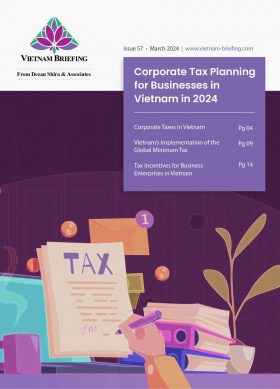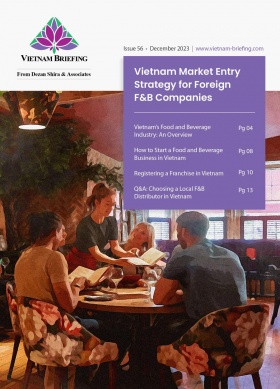Vietnam-U.S. Trade and Investment Relations
Since Vietnam and the U.S. established diplomatic relations in 1995, shared strategic and economic interests have propelled both countries to expand their cooperation across numerous issues. We discuss bilateral trade and investment relations between Vietnam and the U.S. and prospects in light of their recently formed Comprehensive Strategic Partnership.
The economic relationship between Vietnam and the U.S. has prospered in recent times, witnessing significant expansion in trade, investment, and bilateral agreements. Vietnam counts the U.S. as its second-largest trade partner and primary export destination, whereas the U.S. ranks Vietnam as its ninth-largest trading partner.
In this article, we look at the latest data on Vietnam-U.S. two-way trade and investment and provide an overview of their various bilateral tax and investment treaties.
Diplomatic relations
Vietnam established diplomatic relations with the U.S. in 1995, marking a significant milestone in the bilateral relationship. Following the normalization of relations, the two countries quickly moved to expand their cooperation across various sectors. The first official visit of a high-ranking Vietnamese official to the U.S. occurred soon after, setting the stage for enhanced diplomatic and economic exchanges.
Diplomatic representations were established in both countries, with the U.S. opening its embassy in Hanoi and Vietnam establishing its embassy in Washington, D.C. Significant progress was made when the first resident Ambassador of the U.S. to Vietnam was appointed in 1997, cementing the diplomatic presence.
Important milestones in the relationship include high-level visits and agreements aimed at strengthening ties. For example, in 2000, President Bill Clinton’s visit to Vietnam was a historic event that paved the way for increased cooperation. The establishment of a Consulate General in Ho Chi Minh City further enhanced U.S. presence and engagement in Vietnam.
The bilateral relationship saw a major boost in 2013 when the two countries signed a comprehensive partnership agreement, highlighting their commitment to deepening cooperation in various fields, such as trade, education, and security. This was followed by the historic visit of General Secretary Nguyễn Phú Trọng to the U.S. in 2015, marking the first visit by a top Vietnamese leader to the country since normalization.
In September 2023, Vietnam’s General Secretary Nguyen Phu Trong and U.S. President Joe Biden convened in Hanoi to advance their nations’ relationship to a Comprehensive Strategic Partnership, highlighting peace, cooperation, and sustainable development. The U.S. expressed its support for Vietnam’s development as a strong, independent, and prosperous nation.
Trade and investment
Vietnam and the U.S. have established strong trade ties that have seen substantial growth over time, bolstered by numerous significant developments further enhancing their economic relationship.
Vietnam-U.S. trade data
As per OEC data, in March 2024, the U.S. leading exports to Vietnam included raw cotton valued at US$78.2 million, soybeans at US$74 million, telephones at US$46.5 million, hydrogen at US$41.1 million, and integrated circuits at US$40.3 million. During the same period, Vietnam’s top exported items to the U.S. were telephones worth US$1.81 billion, other furniture at US$602 million, semiconductor devices at US$407 million, computers at US$324 million, and seats at US$319 million.
|
Vietnam-U.S. Goods Trade in Q1 2024 |
|||||||
| Time period | Vietnam’s exports to the U.S. (US$ billion) | Percentage of total export turnover | YoY increase (%) |
Trade surplus (US$ billion) |
Vietnam’s share of U.S. imports (%) | U.S. exports to Vietnam (US$ billion) | Vietnam’s import of U.S. electrical equipment (US$ billion) |
| Q1 2024 | 25.77 | 27.7 | 24.1 | 22.38 | 3 | 9.79 | 1.71 |
|
Vietnam-U.S. Trade in Goods – 2019 to 2024 (US$ Million) |
|||||
|
Year |
2019 |
2020 |
2021 |
2022 |
2023 |
|
Exports |
13,50 |
12,354 |
12,930 |
13,779 |
12,815 |
|
Imports |
67,681 |
80,038 |
102,387 |
128,362 |
115,796 |
According to the Bureau of Economic Analysis (BEA), in 2023, Vietnam was the destination for 0.4 percent of all U.S. exports and the source of 3 percent of U.S. imports. The leading category for U.S. exports to Vietnam was industrial supplies and materials, comprising 33.6 percent of these exports. On the import side, consumer goods (excluding food and automotive) were the predominant category, making up 48.7 percent of U.S. imports from Vietnam.
|
Top Exports by U.S. to Vietnam |
||
|
Rank |
Exports |
Value (US$ billion) |
|
1 |
Industrial supplies and materials |
4.3 |
|
2 |
Foods, feeds, and beverages |
2.0 |
|
3 |
Capital goods except automotive |
1.9 |
|
4 |
Travel services (for all purposes including education) |
1.4 |
|
5 |
Consumer goods except food and automotive |
1.4 |
|
Top Imports by U.S. from Vietnam |
||
|
Rank |
Imports |
Value (US$ billion) |
|
1 |
Consumer goods except food and automotive |
56.3 |
|
2 |
Capital goods except automotive |
43.2 |
|
3 |
Industrial supplies and materials |
6.7 |
|
4 |
Foods, feeds, and beverages |
3.8 |
|
5 |
Automotive vehicles, parts, and engines |
3.2 |
Services trade
According to the Office of the U.S. Trade Representative (USTR), in 2022, the U.S. saw a notable increase in its services exports to Vietnam, totaling an estimated US$2.4 billion. This figure marked a significant rise of 26.1 percent, equivalent to US$502 million, compared to 2021, and a substantial 48 percent increase from the levels seen in 2012. Key sectors driving these exports included travel, transportation, and financial services, highlighting growing opportunities in these fields within the Vietnamese market.
Concurrently, U.S. imports of services from Vietnam also experienced a robust growth trajectory in 2022. Imports totaled approximately US$874 million, reflecting an 88.0 percent increase, or US$409 million, from 2021 levels, and a solid 25 percent rise from 2012. This surge underscores Vietnam’s expanding capabilities in delivering services that meet U.S. demand, thereby strengthening bilateral economic ties.
The upward trend in services trade between Vietnam and the U.S. signifies a deepening economic relationship, where both cs benefit from enhanced cooperation and mutual exchange. As Vietnam continues to advance its services sector capabilities, particularly in areas like travel, transportation, and financial services, opportunities for further growth and collaboration between the two countries are expected to flourish.
| Vietnam’s Services Trade with the U.S. in 2022 | |||||
| Year | US exports of services to Vietnam (US$ billion) | Increase from the previous year (%) | Leading sectors for US services exports to Vietnam | US imports of services from Vietnam (US$ billion) | US services trade surplus with Vietnam (US$ billion) |
| 2022 | 2.4 | 26.1 | Travel, transportation, financial services | 0.874 | 1.6 |
American direct investments into Vietnam
Foreign direct investment (FDI) is vital for Vietnam’s economic growth, leading the government to adopt policies that promote export-oriented manufacturing. The U.S. serves as a key source for potentially large-scale investments.
As per a Thematic report, by the end of April 2024, American businesses had invested over US$12 billion in Vietnam, spanning more than 1,300 projects. This positioned the U.S. as the 11th largest investor in Vietnam by investment value.
While Vietnam-U.S. trade relations are strong, U.S. foreign direct investment (FDI) in Vietnam is relatively small compared to the US$6.58 trillion U.S. FDI into Asia and ASEAN markets (up to 2022). According to a June 2024 report published by Guotai Junan Securities (Vietnam) Corp, using VCCI data, U.S. firms were invested in 17 out of 21 sub-sectors in Vietnam. The accommodation and food service industry accounted for 42.3 percent of the total registered capital, while manufacturing and processing accounted for 20.3 percent. The largest U.S. FDI project in Vietnam is Winvest Investment’s US$4.1 billion venture in Ba Ria – Vung Tau, a 5-star resort and entertainment venture established in 2007.
Prominent U.S. companies such as Citigroup, Apple, Intel, Nike, Chevron, Ford, Coca-Cola, and KFC have long-term investments and operations in Vietnam.
Bilateral trade, investment, and tax treaties
U.S.-Vietnam Trade and Investment Framework Agreement (TIFA)
In 2007, Vietnam and the U.S. entered into a Trade and Investment Framework Agreement (TIFA), establishing a strategic framework and principles for discussions on trade and investment issues between the two countries.
The agreement led to the creation of the U.S.-Vietnam Council on Trade and Investment. This council includes representatives from both parties and is co-chaired by the Office of the U.S. Trade Representative (USTR) and Vietnam’s Ministry of Trade.The council is vested with the power to:
- Monitor trade and investments between parties, identify opportunities for expanding trade and investments and identify relevant issues that may be appropriate for negotiation in an appropriate forum.
- Consider specific trade and investment matters of interest to the parties including issues under the Bilateral Trade Agreement.
- Identify and work to remove impediments to trade and investment between the parties.
- Establish ad-hoc working groups on specific issues, where appropriate and agreed upon by the parties, to facilitate its work.
- Seek the advice of the business community and civil society, where appropriate on matters related to the council’s work.
Bilateral Trade Agreement (BTA)
Vietnam and the U.S. have signed a BTA in 2001, which took almost 5 years to negotiate, committing both countries to ensure fair market access for each other’s products, businesses, and nationals.
The BTA granted Vietnam “conditional most favored nation (MFN) trade status,” also known as “normal trade relations” (NTR). On December 29, 2006, President George W. Bush conferred permanent normal trade relations (PNTR) status on Vietnam, a crucial step in Vietnam’s accession to the World Trade Organization (WTO).
This significantly lowered tariffs on Vietnamese products. In return, Vietnam pledged to reform its trade and investment regulations to create a fairer environment for U.S. businesses and products, with many commitments being phased in over several years to accommodate Vietnam’s economic transition.
Nevertheless, it must be noted that shortly after extending NTR status to Vietnam in 2001, the U.S. government designated Vietnam as a “nonmarket economy” (NME) for the purposes of antidumping and countervailing duty (AD/CVD) cases – a designation that the Vietnam government has long sought to remove. The U.S. Department of Commerce will complete their review in late July this year.
Vietnam-U.S. double taxation treaty
In 2015, Vietnam and the U.S. signed a double taxation treaty that was ratified by Vietnam but not by the U.S. due to changes in its own tax code in 2020, necessitating a renegotiation of the treaty.
The agreement covers U.S. federal income taxes levied under the Internal Revenue Code (excluding social security and unemployment taxes), as well as U.S. federal taxes imposed on the investment income of foreign private foundations. Additionally, it addresses Vietnam’s personal income tax and business income tax.
The treaty outlines regulations on capital gains taxes, withholding taxes on dividends, interest, and royalties, and specifies the limitation of benefits.
Conclusion
Despite the impressive trade figures, U.S. FDI in Vietnam remains modest compared to its overall investment in Asia. However, top U.S. firms in critical sectors, textiles, and consumer-facing industries have established a strong presence in Vietnam, contributing to its national economic development and showcasing the potential for future investment opportunities.
As Vietnam and the U.S. continue to build on their Comprehensive Strategic Partnership, the outlook for their expanded economic relationship is promising. With ongoing efforts to enhance trade, investment, and diplomatic ties, both countries are well-positioned to achieve mutual growth and prosperity in the years to come.
About Us
Vietnam Briefing is published by Asia Briefing, a subsidiary of Dezan Shira & Associates. We produce material for foreign investors throughout Asia, including ASEAN, China, and India. For editorial matters, contact us here and for a complimentary subscription to our products, please click here. For assistance with investments into Vietnam, please contact us at vietnam@dezshira.com or visit us at www.dezshira.com.
Dezan Shira & Associates assists foreign investors throughout Asia from offices across the world, including in Hanoi, Ho Chi Minh City, and Da Nang. We also maintain offices or have alliance partners assisting foreign investors in China, Hong Kong SAR, Dubai (UAE), Indonesia, Singapore, Philippines, Malaysia, Thailand, Bangladesh, Italy, Germany, the United States, and Australia.
- Previous Article Vietnam Sets Record for Newly Established Firms in the First Five Months of 2024
- Next Article HCMC Announces Labor and Employment Strategy Through 2025: Key Goals








